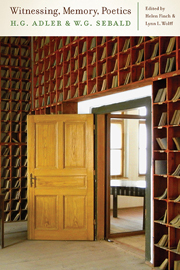Book contents
- Frontmatter
- Contents
- Acknowledgments
- List of Abbreviations
- Introduction: The Adler-Sebald Intertextual Relationship as Paradigm for Intergenerational Literary Testimony
- Part I Intertexts in Context
- 1 Opening Address: The Connections between H. G. Adler and W. G. Sebald, from a Personal Perspective
- 2 Memory's Witness—Witnessing Memory
- 3 Writing the Medusa: A Documentation of H. G. Adler and Theresienstadt in W. G. Sebald's Library
- Part II Witnessing Trauma and the Poetics of Witnessing
- Part III Memory, Memorialization and the Re-Presentation of History
- Part IV Literary Legacies and Networks
- Afterword
- Bibliography
- Notes on the Contributors
- Index
2 - Memory's Witness—Witnessing Memory
from Part I - Intertexts in Context
Published online by Cambridge University Press: 05 October 2014
- Frontmatter
- Contents
- Acknowledgments
- List of Abbreviations
- Introduction: The Adler-Sebald Intertextual Relationship as Paradigm for Intergenerational Literary Testimony
- Part I Intertexts in Context
- 1 Opening Address: The Connections between H. G. Adler and W. G. Sebald, from a Personal Perspective
- 2 Memory's Witness—Witnessing Memory
- 3 Writing the Medusa: A Documentation of H. G. Adler and Theresienstadt in W. G. Sebald's Library
- Part II Witnessing Trauma and the Poetics of Witnessing
- Part III Memory, Memorialization and the Re-Presentation of History
- Part IV Literary Legacies and Networks
- Afterword
- Bibliography
- Notes on the Contributors
- Index
Summary
Introduction
Two writers, born within 350 miles of each other, and yet worlds apart. Two writers, who would come to live, as exiles, within 100 miles of each other, work in the same academic field, share at least one important friend (Michael Hamburger) as well as an obsession with the Holocaust and its representation in literature and scholarship, and yet who never met or corresponded with one another. Two writers, the younger of whom not only read the other's works extensively but also placed him as a figure in his own text while openly using maps and figures from the elder writer's works, though the younger never wrote on or discussed the importance of the other writer in any article or interview. Finally, two writers, the older one having lived in almost complete obscurity despite publishing twenty-six books in his lifetime and several posthumous volumes since, while the younger rocketed to literary fame in middle age only to have his life end early in a terrible car crash—the elder writer having died peacefully in London years before at age seventy-eight despite having suffered the cataclysms of Theresienstadt, Auschwitz, Niederorschel, and Langenstein.
- Type
- Chapter
- Information
- Witnessing, Memory, PoeticsH. G. Adler and W. G. Sebald, pp. 29 - 54Publisher: Boydell & BrewerPrint publication year: 2014



